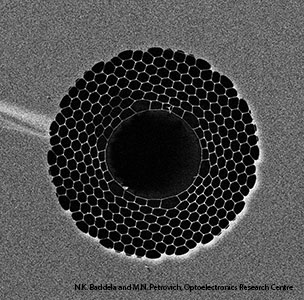
A honeycomb of 200-nm-thick struts of silica glass make up the 37 cells in the hollow core of this photonic bandgap fiber.
Scientists in the United Kingdom have claimed a new record transmission rate of 73.7 Tbit/s through a 37-cell hollow-core photonic bandgap fiber (HC-PBGF) using mode division multiplexing. In a postdeadline paper at this year’s Optical Fiber Communication Conference and Exposition and National Fiber Optic Engineers Conference, senior research fellow Yongmin Jung and colleagues at the University of Southampton Optoelectronics Research Centre fabricated the first low-loss broadband 37-cell HC-PBGF that exploits an absence of surface modes and low crosstalk in the fiber.
The Southampton group, along with researchers at the COBRA Institute, Netherlands; Coriant R&D, Germany; and Technische Universität München, Germany, expanded upon previous success with a 19-cell hollow core by increasing the design to 37 cells, thus reducing surface scattering, which is the primary loss mechanism in such fibers. The team fabricated a 37-µm-diameter fiber with a 4.4 µm cladding pitch and relative hole size of 0.97 to attain a low minimum fundamental mode loss of 3.3 dB/km at 1550 nm and a wide 3-dB bandwidth of about 85 nm centered in the telecom C-band. They then demonstrated mode-division multiplexed transmission in the three lowest order optical modes—a record for this type of fiber.
HC-PBGF features a lattice of honeycombed air holes around a larger core of air. Because the signal travels through air, data can transmit much faster than through conventional fiber. In addition, the method of transmission is via a photonic bandgap effect rather than total internal reflection as in conventional fiber. While HC-PBGF beats solid fiber by having lower nonlinearity, potential for lower loss and low latency, several issues remain to be studied, particularly that of processing the modes at the receiver using multiple-input-multiple-output techniques.
Researchers are now investigating the use of novel optical fiber in a variety of applications including telecom, nonlinear pulse reshaping and high-power laser delivery and fiber sensors, among other things.
